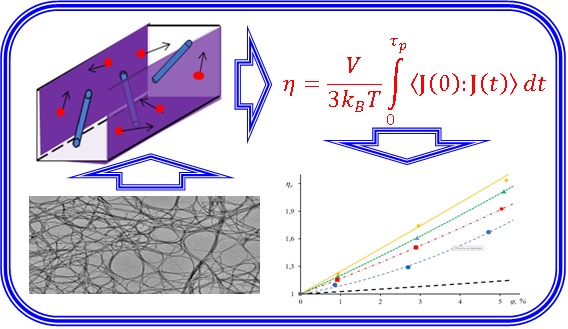Nanosystems: Phys. Chem. Math., 2024, 15 (1), 37–45
Molecular dynamics study of nanofluids viscosity with carbon tubes
Valery Ya. Rudyak – Novosibirsk State University of Architecture and Civil Engineering, Novosibirsk, Russia; valery.rudyak@mail.ru
Sergey L. Krasnolutskii – Novosibirsk State University of Architecture and Civil Engineering, Novosibirsk, Russia; sergius-l@mail.ru
Evgeniy V. Lezhnev – Novosibirsk State University of Architecture and Civil Engineering, Novosibirsk, Russia; lionlev@yandex.ru
Corresponding author: Valery Ya. Rudyak, valery.rudyak@mail.ru
PACS 61.20.Ja, 61.48.De, 66.20.Cy
DOI 10.17586/2220-8054-2024-15-1-37-45
ABSTRACT The purpose of this paper is molecular dynamics simulation of viscosity of benzene-based nanofluids with carbon nanotubes, and carbon or copper nanoparticles. The nanotubes diameter and lengths were 1.1 nm and 1.1, 3.5, 7.2, 14.6 nm, respectively. The size of spherical nanoparticle was 1.39, 2.5, and 3.2 nm. The viscosity is calculated using the fluctuation-dissipation theorem (the Green–Kubo formula). It was shown that the viscosity coefficient of all the studied nanofluids with carbon nanotubes increases with their concentration and length. This increase is significantly higher than predicted by the corresponding theories for coarse dispersed fluids. At given weight concentrations, the viscosity coefficient of nanofluids with carbon nanotubes is higher than that of nanofluids with spherical particles. The increase in viscosity of nanofluids compared to
that of the base fluid is explained by the structuring of the base fluid molecules in the vicinity of nanoparticles or carbon nanotubes.
KEYWORDS viscosity, molecular dynamics method, nanofluid, nanoparticles, carbon nanotubes
ACKNOWLEDGEMENTS This research was financially supported by the Russian Science Foundation (Agreement No. 20-19-00043). The authors thank A. A. Belkin and T. A. Rafalskaya for the multiple discussions of the results obtained.
FOR CITATION Rudyak V.Ya., Krasnolutskii S.L., Lezhnev E.V. Molecular dynamics study of nanofluids viscosity with carbon tubes. Nanosystems: Phys. Chem. Math., 2024, 15 (1), 37–45.
[In Russian] Рудяк В.Я., Краснолуцкий С.Л., Лежнев Е.В.
Молекулярно-динамическое изучение вязкости наножидкостей с углеродными трубками
УДК 532.13, 532.584, 538.93, 544.77
АННОТАЦИЯ Целью данной работы является молекулярно-динамическое моделирование вязкости наножидкостей на основе бензола с углеродными нанотрубками и наночастицами из углерода и меди. Диаметр и длина нанотрубок соответственно равны 1,1 нм и 1.1, 3.5, 7.2, 14.6 нм. Размер сферических наночастиц составлял 1.39, 2.5 и 3.2 нм. Вязкость рассчитывалась с использованием флуктуационно-диссипационной теоремы (формула Грина-Кубо). Показано, что коэффициент вязкости всех исследованных наножидкостей с углеродными нанотрубками увеличивается с увеличением их концентрации и длины. Это увеличение значительно выше, чем предсказывается соответствующими теориями для крупнодисперсных жидкостей. При заданных массовых концентрациях коэффициент вязкости наножидкостей с углеродными нанотрубками выше, чем у наножидкостей со сферическими частицами. Увеличение вязкости наножидкостей по сравнению с вязкостью базовой жидкости объясняется структурированием молекул базовой жидкости вблизи наночастиц или УНТ.
КЛЮЧЕВЫЕ СЛОВА вязкость, метод молекулярной динамики, наножидкость, наночастицы, углеродные нанострубки.
